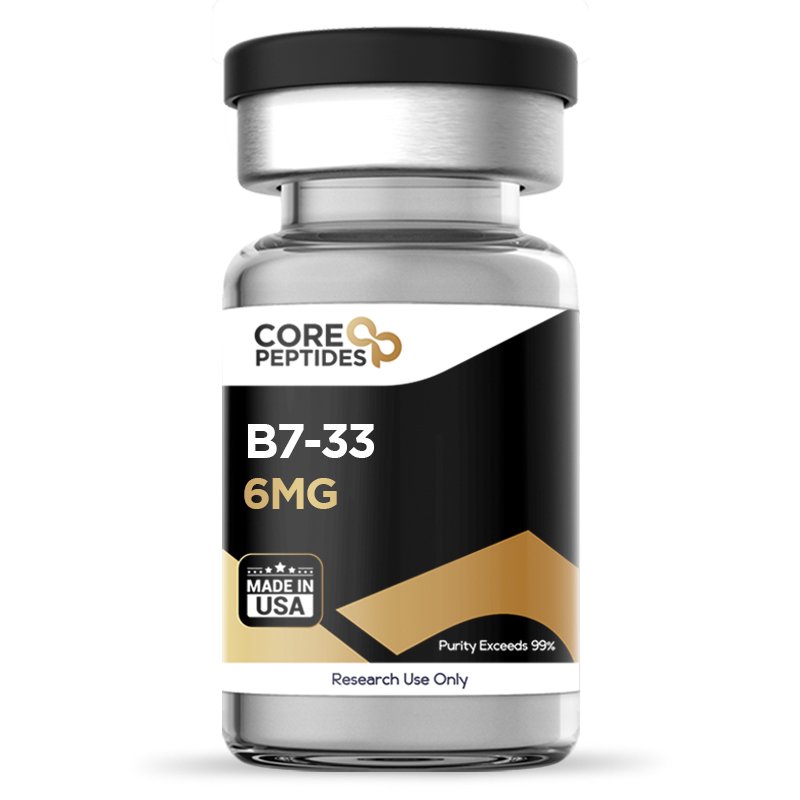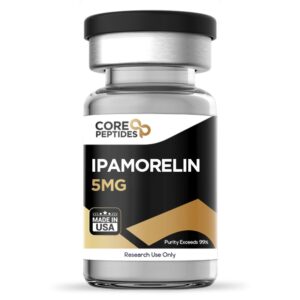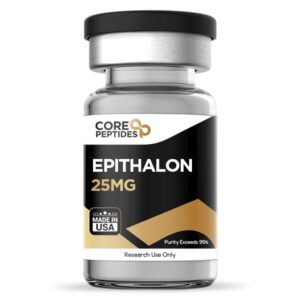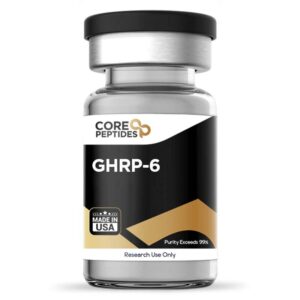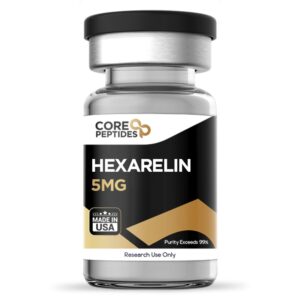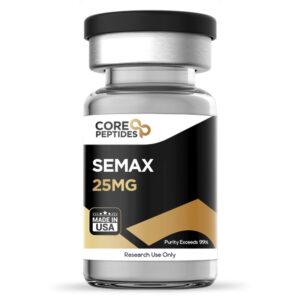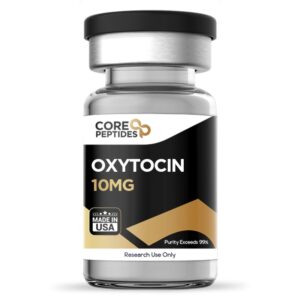B7-33 (6mg)
$57.00
Size: 6mg
Contents: B7-33 (6mg)
Form: Lyophilized powder
Purity: >99%
SKU: P-B733-6
FREE Shipping on $200+ orders
FREE Bacteriostatic Water (30ml) on $200+ orders
Discount per Quantity
| Quantity | Discount | Price |
|---|---|---|
| 5 - 8 | 5% | $54.15 |
| 9 + | 10% | $51.30 |
B7-33 Peptide
H2-relaxin is a naturally occurring, endogenous protein compound, which was synthetically mimicked and named the “B7-33” peptide. The H2-relaxin protein class comprises relaxin, H3-relaxin, insulin-like peptide-3, and insulin-like peptide-5. All these proteins have been suggested to exhibit a variety of biological actions, including possibly affecting genetic functions and the reproductive, musculoskeletal, and cardiovascular systems.(2) Considered structurally similar to H2-relaxin, the synthetic equivalent B7-33 may possess anti-fibrotic potential.
There are four different receptors that these naturally produced relaxin proteins are speculated to bind with, namely RXFP-1, RXFP-2, RXFP-3, and RXFP-4. Each receptor has a different action, as outlined below:(2)
- RXFP-1 receptor is suggested to influence sperm motility
- RXFP-2 receptor appears to impact testicular development
- RXFP-3 receptor may play a role in circadian rhythm and sleep cycle regulation
- RXFP-4 receptor has shown indications of affecting hunger hormone signaling cycles
Due to the variety of receptors involved and a wide range of biological impact, extensive research has been conducted on the relaxin protein and its analogs, such as the B7-33 peptide, to fully understand their potential.
Overview
B7-33 is a singular chain peptide, a smaller analogous derivative of the endogenous relaxin protein.(3) Typically, the relaxin peptide comprises four components - a signal peptide, B chain, C chain, and COOH terminal. Several studies were conducted initially to replicate these peptide structures, however the researchers reported that results indicated it being highly insoluble and inactive. After extensive subsequent research, scientists modified the structure by producing a B chain and elongating the COOH terminal, thereby forming the first-ever soluble analog - B7-33 peptide - in 2016.(3)
Besides the structural difference, the peptide has other variations from the endogenous protein. B7-33 peptide has been suggested to act via the pERK pathway instead of the cAMP pathway. The pERK pathway is a signaling route within cells that may affect cell function, often related to cell growth and survival. In contrast, the cAMP pathway involves different cellular activities primarily related to energy balance and metabolism. H2-relaxin has been suggested to produce antifibrotic potential via the cAMP pathway, which may stimulate tumor formation.(1) Furthermore, the peptide may have a strong affinity towards the RXFP-1 receptors. The peptide appears to bind with these RXFP-1 receptors, stimulating the pERK pathway, which then may lead to increased synthesis of MMP-2 matrix metalloproteinase chemicals. MMP-2 is an enzyme that breaks down proteins and plays a crucial role in tissue remodeling and repair. These chemicals then possibly inhibit the scarring of tissues, thereby preventing fibrosis.(1) Fibrosis is considered the formation of excess fibrous connective tissue in an organ or tissue in a reparative or reactive process, which is associated with a loss of function.
Chemical Makeup
Molecular Formula: C131H228N40O37S
Molecular Weight:51 g/mol
Other Known Titles: (B7-33)H2, GTPL9321
Research and Clinical Studies
B7-33 Peptide and Vasoprotection
This 2017 study(4) was conducted on male Wistar murine models where their tails were presented with a control compound (which was sodium acetate), H2 relaxin, or B7-33 peptide. After three hours, these mice were examined for their vascular functions, mainly in the mesenteric artery, renal artery, and abdominal aorta. While the results were not as promising in the renal artery and abdominal aorta, B7-33 and H2 relaxin exhibited potential vasodilatory properties in the mesenteric artery. Thus, the results suggest that both B7-33 and serelaxin may preferentially augment bradykinin-induced endothelium-dependent relaxation, particularly emphasizing the mesenteric artery in rats. This augmentation appears to be linked to enhanced endothelium-derived hyperpolarization.
To understand better, the researchers reported an additional study(4) carried out in female murine models experimentally induced with endothelial dysfunction. These mice were then either given B7-33 or H2 relaxin. Following the study, the researchers suggested that both compounds may have helped combat and prevent the further spread of endothelial dysfunction in mice. These results suggest that B7-33 has the potential to replicate the vasoprotective action of H2 relaxin and thereby protect blood vessels from further damage.
B7-33 Peptide and Preeclampsia
Preeclampsia is a pregnancy ailment characterized by increased hypertension in mothers and decreased fetal weight. This clinical study(5) was conducted to understand the potential of B7-33 peptide in pregnant females with preeclampsia. A cell culture of cytotrophoblasts (CTBs) was used. Cytotrophoblasts are the cells found in the inner cellular layer of the embryo. These cells were given either control compound, a marinobufagenin steroid, or glucose for two days. Following this preparation, some of these cells were given either a relaxin antagonist, or the B7-33 compound. Upon examination, the cells given B7-33 peptide appeared to exhibit an upregulation of the vascular endothelial growth factor, VEGF. Cells that were given relaxin antagonists exhibited apparent reduced VEGF concentration. VEGF is thought to stimulate the proliferation and migration of endothelial cells, which line the interior surfaces of blood vessels. By potentially enhancing these processes, VEGF may play a vital role in forming new vascular structures, essential for supplying tissues with oxygen and nutrients, especially during rapid growth or healing periods. VEGF's actions are primarily mediated through two tyrosine kinase receptors, VEGFR-1 and VEGFR-2, located on the surface of endothelial cells. The binding of VEGF to these receptors is thought to trigger a cascade of signaling pathways that could lead to endothelial cell proliferation, migration, and survival.
B7-33 Peptide and Anti-Fibrosis
Studies(6)(7) have suggested that when presented with a fully extended strain of H2 relaxin protein, it may induce an increased heart rate and possibly stimulate the spread of carcinogenic cells. This is mainly attributed to its mechanism as it appears to activate the cAMP pathway. Hence, researchers are looking for a derivative that might produce the exact biological action of anti-fibrosis without cAMP activation. When the peptide was exposed in mice with myocardial infarction, it was reported to result in almost 50% reduction in cardiac tissue fibrosis.
Furthermore, a study(1) was also conducted in mice with prostate diseases. These mice were presented with two different concentrations of B7-33 peptide. At both concentrations, the results were the same, and researchers suggested that the compound might contribute to the development of fibrosis without promoting the spread of prostate tumors. This suggested that the peptide may have the potential to act via the pERK pathway and not via cAMP activation. The designation "pERK" refers to the phosphorylated state of extracellular signal-regulated kinase (ERK), indicating its activated status. It is hypothesized that the activation pathway initiates when a growth factor interacts with its corresponding receptor on the cellular surface, potentially activating the receptor's intrinsic kinase capabilities. This interaction is believed to initiate a sequence of phosphorylation events, transmitting the signal through a network of intermediary proteins, such as RAF and MEK (MAPK/ERK kinase). This sequence is thought to ultimately result in the phosphorylation and subsequent activation of ERK. Following activation, it is suggested that ERK translocates to the nucleus where it may phosphorylate various transcription factors, potentially leading to changes in gene expression that might influence cellular processes, including division and differentiation.
B7-33 Peptide as a Coating Material
In one animal study(8), a peptide-coated device was implanted in murine models. The researchers were curious to see if the peptide might counteract possible fibrotic actions in the mice. As a result of this peptide release from the device coating, the reduction in device thickness (by fibrosis) was reported to be decreased by 49.2% over the 6-week duration of the study.
B7-33 peptide is available for research and laboratory purposes only. Please review and adhere to our Terms and Conditions before ordering.
References:
- Mohammed Akhter Hossain et al, A single-chain derivative of the relaxin hormone is a functionally selective agonist of the G protein-coupled receptor, RXFP1, Drug Discovery Biology Pharmacology Monash Biomedicine Discovery Institute, Vol 7, 2016. https://research.monash.edu/en/publications/a-single-chain-derivative-of-the-relaxin-hormone-is-a-functionall
- R J Summers, Recent progress in the understanding of relaxin family peptides and their receptors, British Journal of Pharmacology, Vol 174, issue 10, pg 915-920. https://doi.org/10.1111/bph.13778
- Nitin A Patil et al, Relaxin family peptides: structure–activity relationship studies, British Pharmacological Society, vol 174 issue 10, published 06 December 2016. https://doi.org/10.1111/bph.13684
- Marshall SA, O'Sullivan K, Ng HH, Bathgate RAD, Parry LJ, Hossain MA, Leo CH. B7-33 replicates the vasoprotective functions of human relaxin-2 (serelaxin). Eur J Pharmacol. 2017 Jul 15;807:190-197. doi: 10.1016/j.ejphar.2017.05.005. Epub 2017 May 3. PMID: 28478069. https://pubmed.ncbi.nlm.nih.gov/28478069/
- S.H Afroze et al, Abstract P3042: Novel Peptide B7-33 and It's Lipidated Derivative Protect Cytotrophoblasts From Preeclampsia Phenotype in a Cellular Model of the Syndrome, 4 Sep 2019. https://doi.org/10.1161/hyp.74.suppl_1.P3042
- Silvertown JD, Ng J, Sato T, Summerlee AJ, Medin JA. H2 relaxin overexpression increases in vivo prostate xenograft tumor growth and angiogenesis. Int J Cancer. 2006 Jan 1;118(1):62-73. https://pubmed.ncbi.nlm.nih.gov/16049981
- Shu Feng, Irina U. Agoulnik, Natalia V. Bogatcheva, Aparna A. Kamat, Bernard Kwabi-Addo, Rile Li, Gustavo Ayala, Michael M. Ittmann and Alexander I. Agoulnik, Relaxin Promotes Prostate Cancer Progression, March 2007. https://clincancerres.aacrjournals.org/content/13/6/1695
- N.Welch et al, Coatings Releasing the Relaxin Peptide Analogue B7-33 Reduce Fibrotic Encapsulation, ACS Applied Materials and Interfaces, Nov 2019. https://www.researchgate.net/publication/337205944_Coatings_Releasing_the_Relaxin_Peptide_Analogue_B7-33_Reduce_Fibrotic_Encapsulation

